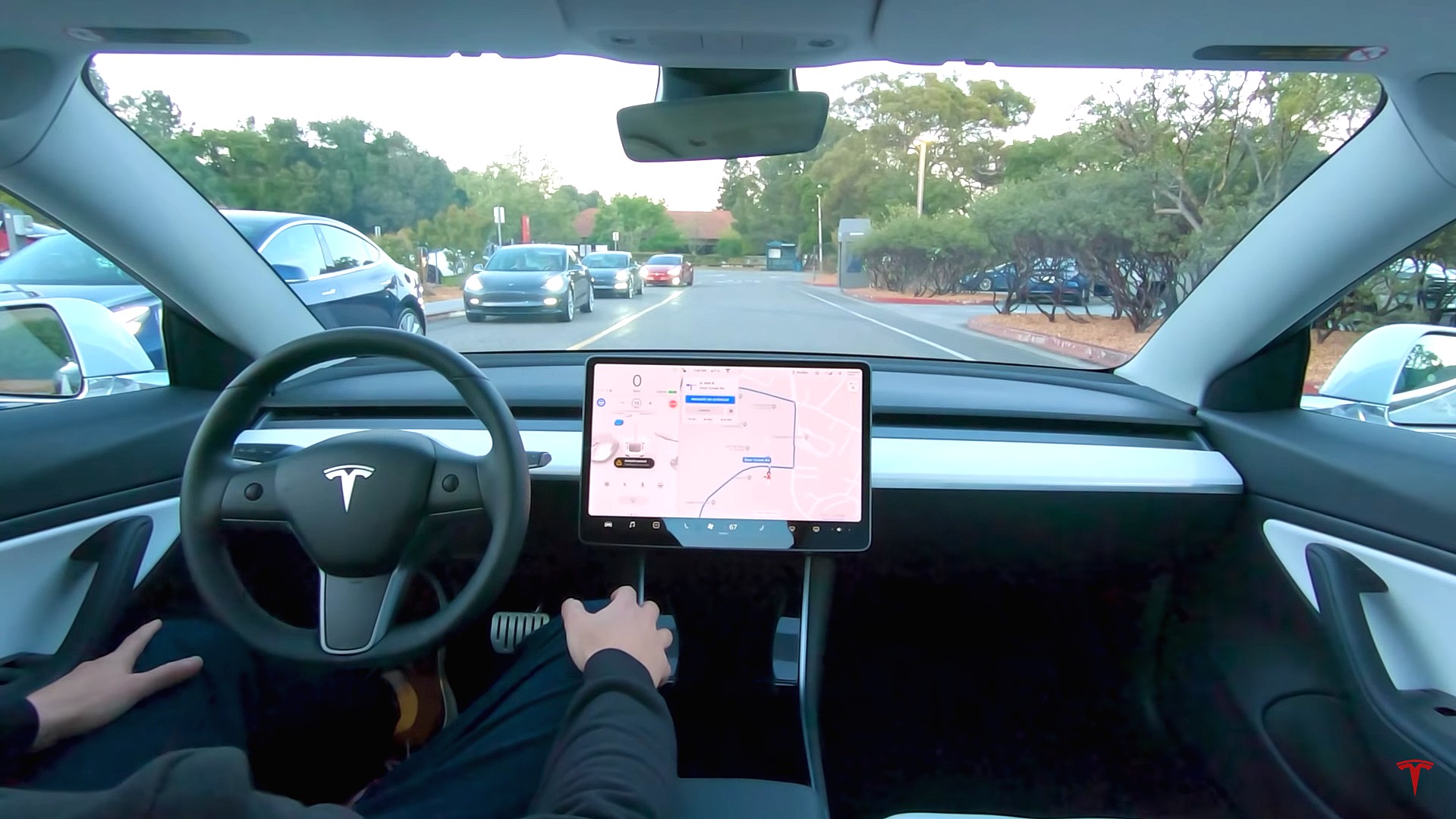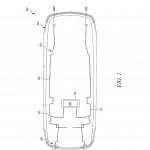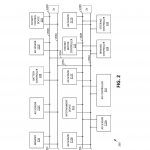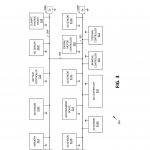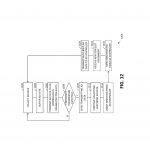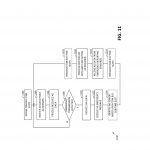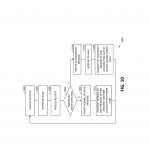A recently published Tesla patent application titled “Autonomous Driving System Emergency Signaling” describes a method of quickly communicating emergency information from vehicle sensors feeding into autonomous driving software. The new communication method will improve Autopilot’s response in emergency situations, thereby reducing the probability of accidents.
Tesla’s invention takes latency in data transmission into account as an area of improvement. In general, critical information can get stuck waiting to be processed by a computer after non-critical information that’s ahead of it. Under Tesla’s US Patent Application No. 2019/0138018, critical emergency situations detected by sensors are moved to the front of the line for priority processing and response. Tesla’s invention achieves this using two main approaches.
- Tesla’s self-driving patent hints at faster collision response times. | Image: Tesla/USPTO
- Tesla’s self-driving patent hints at faster collision response times. | Image: Tesla/USPTO
- Tesla’s self-driving patent hints at faster collision response times. | Image: Tesla/USPTO
First, the transmission from sensors that detect an emergency sends their findings to the main computer at a higher transmit power than other messages. Other signals at lower power transmissions are then interpreted as ‘background noise’ compared to the emergency signal. This process is described in the patent application as follows:
“When an autonomous driving emergency event is detected by an autonomous driving sensor…the [sensor] transmits the autonomous driving emergency message in a non-assigned time slot at a higher transmit power level than a transmit power level of an autonomous driving sensor…Because the autonomous driving emergency message is transmitted at a higher power level than the transmission from the autonomous driving sensor, the transmission from the autonomous driving sensor may be treated as background noise by the autonomous driving controller to thereby receive and decode of the autonomous driving emergency message.”
- Tesla’s self-driving patent hints at faster collision response times. | Image: Tesla/USPTO
- Tesla’s self-driving patent hints at faster collision response times. | Image: Tesla/USPTO
- Tesla’s self-driving patent hints at faster collision response times. | Image: Tesla/USPTO
In a second approach, the autonomous driving sensors that encounter an emergency message are programmed to stop sending signals, and the vehicle’s main computer will direct them to resume communications after receiving the emergency message. This process is described in the patent as follows:
“…if an emergency transmission is detected…the autonomous driving sensor ceases transmitting autonomous driving data. Such cessation may continue for one assigned time slot, for more than one assigned slots, and/or until the autonomous driving sensor receives direction from the autonomous driving controller to continue transmitting autonomous driving data or receives a new…bus time slot assignment from the autonomous driving controller. During this time period…the autonomous driving sensor continues to collect and buffer autonomous driving data.”
Several variations of achieving these two main concepts are also described in the application and invention claims, including managing the specifics of the transmit power level differences and reassigning time slots for sensors to communicate on the data bus. Overall, this recent patent application is yet another indicator of Tesla’s continued improvement of its autonomous driving capabilities.
Tesla’s advances in the autonomous driving arena have been touted by CEO Elon Musk and industry experts alike. ARK Invest analyst James Wang recently estimated that the all-electric car maker’s decision to develop its Full Self-Driving computer chip in-house put the company four years ahead of the competition. Musk, for his part, declared the chip the best in the world at Tesla’s Investor Autonomy Day. “It seems improbable. How could it be that Tesla, who has never designed a chip before, would design the best chip in the world? But that is objectively what has occurred,” Elon touted.
While Tesla has yet to roll out the total capabilities of its Full Self-Driving suite, Musk has said on several occasions that the software will be “feature complete” by the end of 2019 with only regulatory hurdles left for full release.
News
Tesla launches in India with Model Y, showing pricing will be biggest challenge
Tesla finally got its Model Y launched in India, but it will surely come at a price for consumers.

Tesla has officially launched in India following years of delays, as it brought its Model Y to the market for the first time on Tuesday.
However, the launch showed that pricing is going to be its biggest challenge. The all-electric Model Y is priced significantly higher than in other major markets in which Tesla operates.
On Tuesday, Tesla’s Model Y went up for sale for 59,89,000 rupees for the Rear-Wheel Drive configuration, while the Long Range Rear-Wheel Drive was priced at 67,89,000.
This equates to $69,686 for the RWD and $78,994 for the Long Range RWD, a substantial markup compared to what these cars sell for in the United States.
🚨 Here’s the difference in price for the Tesla Model Y in the U.S. compared to India.
🚨 59,89,000 is $69,686
🚨 67,89,000 is $78,994 pic.twitter.com/7EUzyWLcED— TESLARATI (@Teslarati) July 15, 2025
Deliveries are currently scheduled for the third quarter, and it will be interesting to see how many units they can sell in the market at this price point.
The price includes tariffs and additional fees that are applied by the Indian government, which has aimed to work with foreign automakers to come to terms on lower duties that increase vehicle cost.
Tesla Model Y seen testing under wraps in India ahead of launch
There is a chance that these duties will be removed, which would create a more stable and affordable pricing model for Tesla in the future. President Trump and Indian Prime Minister Narendra Modi continue to iron out those details.
Maharashtra Chief Minister Devendra Fadnavis said to reporters outside the company’s new outlet in the region (via Reuters):
“In the future, we wish to see R&D and manufacturing done in India, and I am sure at an appropriate stage, Tesla will think about it.”
It appears to be eerily similar to the same “game of chicken” Tesla played with Indian government officials for the past few years. Tesla has always wanted to enter India, but was unable to do so due to these import duties.
India wanted Tesla to commit to building a Gigafactory in the country, but Tesla wanted to test demand first.
It seems this could be that demand test, and the duties are going to have a significant impact on what demand will actually be.
Elon Musk
Tesla ups Robotaxi fare price to another comical figure with service area expansion
Tesla upped its fare price for a Robotaxi ride from $4.20 to, you guessed it, $6.90.

Tesla has upped its fare price for the Robotaxi platform in Austin for the first time since its launch on June 22. The increase came on the same day that Tesla expanded its Service Area for the Robotaxi ride-hailing service, offering rides to a broader portion of the city.
The price is up from $4.20, a figure that many Tesla fans will find amusing, considering CEO Elon Musk has used that number, as well as ’69,’ as a light-hearted attempt at comedy over the past several years.
Musk confirmed yesterday that Tesla would up the price per ride from that $4.20 point to $6.90. Are we really surprised that is what the company decided on, as the expansion of the Service Area also took effect on Monday?
But the price is now a princely $6.90, as foretold in the prophecy 😂
— Elon Musk (@elonmusk) July 14, 2025
The Service Area expansion was also somewhat of a joke too, especially considering the shape of the new region where the driverless service can travel.
I wrote yesterday about how it might be funny, but in reality, it is more of a message to competitors that Tesla can expand in Austin wherever it wants at any time.
Tesla’s Robotaxi expansion wasn’t a joke, it was a warning to competitors
It was only a matter of time before the Robotaxi platform would subject riders to a higher, flat fee for a ride. This is primarily due to two reasons: the size of the access program is increasing, and, more importantly, the service area is expanding in size.
Tesla has already surpassed Waymo in Austin in terms of its service area, which is roughly five square miles larger. Waymo launched driverless rides to the public back in March, while Tesla’s just became available to a small group in June. Tesla has already expanded it, allowing new members to hail a ride from a driverless Model Y nearly every day.
The Robotaxi app is also becoming more robust as Tesla is adding new features with updates. It has already been updated on two occasions, with the most recent improvements being rolled out yesterday.
Tesla updates Robotaxi app with several big changes, including wider service area
News
Tesla Model Y and Model 3 dominate U.S. EV sales despite headwinds
Tesla’s two mainstream vehicles accounted for more than 40% of all EVs sold in the United States in Q2 2025.

Tesla’s Model Y and Model 3 remained the top-selling electric vehicles in the U.S. during Q2 2025, even as the broader EV market dipped 6.3% year-over-year.
The Model Y logged 86,120 units sold, followed by the Model 3 at 48,803. This means that Tesla’s two mainstream vehicles accounted for 43% of all EVs sold in the United States during the second quarter, as per data from Cox Automotive.
Tesla leads amid tax credit uncertainty and a tough first half
Tesla’s performance in Q2 is notable given a series of hurdles earlier in the year. The company temporarily paused Model Y deliveries in Q1 as it transitioned to the production of the new Model Y, and its retail presence was hit by protests and vandalism tied to political backlash against CEO Elon Musk. The fallout carried into Q2, yet Tesla’s two mass-market vehicles still outsold the next eight EVs combined.
Q2 marked just the third-ever YoY decline in quarterly EV sales, totaling 310,839 units. Electric vehicle sales, however, were still up 4.9% from Q1 and reached a record 607,089 units in the first half of 2025. Analysts also expect a surge in Q3 as buyers rush to qualify for federal EV tax credits before they expire on October 1, Cox Automotive noted in a post.
Legacy rivals gain ground, but Tesla holds its commanding lead
General Motors more than doubled its EV volume in the first half of 2025, selling over 78,000 units and boosting its EV market share to 12.9%. Chevrolet became the second-best-selling EV brand, pushing GM past Ford and Hyundai. Tesla, however, still retained a commanding 44.7% electric vehicle market share despite a 12% drop in in Q2 revenue, following a decline of almost 9% in Q1.
Incentives reached record highs in Q2, averaging 14.8% of transaction prices, roughly $8,500 per vehicle. As government support winds down, the used EV market is also gaining momentum, with over 100,000 used EVs sold in Q2.
Q2 2025 Kelley Blue Book EV Sales Report by Simon Alvarez on Scribd
-

 News3 days ago
News3 days agoTesla debuts hands-free Grok AI with update 2025.26: What you need to know
-

 Elon Musk1 week ago
Elon Musk1 week agoElon Musk confirms Grok 4 launch on July 9 with livestream event
-

 Elon Musk5 days ago
Elon Musk5 days agoxAI launches Grok 4 with new $300/month SuperGrok Heavy subscription
-

 News2 weeks ago
News2 weeks agoTesla Model 3 ranks as the safest new car in Europe for 2025, per Euro NCAP tests
-

 Elon Musk2 weeks ago
Elon Musk2 weeks agoxAI’s Memphis data center receives air permit despite community criticism
-

 News5 days ago
News5 days agoTesla begins Robotaxi certification push in Arizona: report
-

 Elon Musk2 weeks ago
Elon Musk2 weeks agoTesla reveals it is using AI to make factories more sustainable: here’s how
-

 Elon Musk2 weeks ago
Elon Musk2 weeks agoTesla scrambles after Musk sidekick exit, CEO takes over sales

